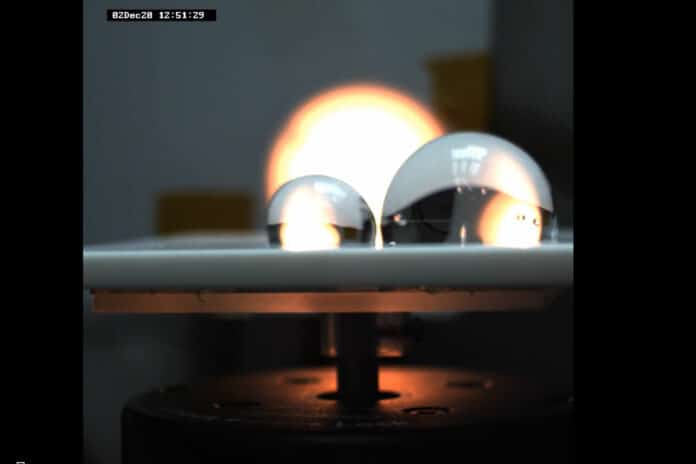Coalescing drops are prominent in rainwater runoff from building facades, cell–cell interaction and cell adhesion to biological tissues, condensing steam for energy generation, etc. While knowledge of the liquid viscosity and surface tension is sufficient to describe the dynamics of freely suspended coalescing drops, the solid–liquid–gas line of contact modulates the dynamics of sessile drops.
In a new study, scientists from Cornell University and Clemson University designed and analyzed droplet experiments on the International Space Station.
At small scales, droplet dynamics are too fast to observe. Hence, the ISS. The lower gravity in space means the team could investigate larger droplets, moving from a couple of millimeters in diameter to 10 times that length.
The scientists sent four different surfaces to the ISS and installed them on a lab table, each of which had a different roughness property. The spread and fusion of the droplets were captured by cameras.
Josh McCraney of Cornell University said, “NASA astronauts Kathleen Rubins and Michael Hopkins would deposit a single drop of the desired size at a central location on the surface. This drop is near, but not touching, a small porthole pre-drilled into the surface. The astronaut then injected water through the porthole, which collects and essentially grows an adjacent drop. Injection continues until the two drops touch, at which point they coalesce.”
The Davis-Hocking model, a straightforward method to simulate droplets, was the subject of the studies. A water droplet resting on a surface has a portion that touches the air, creating an interface and a portion that makes contact with the surface, creating an edge or contact line. The equation for the contact line is described by the Davis-Hocking model. The Davis-Hocking model’s parameter space was enlarged and confirmed by the experimental findings.
To see his research successfully carried out aboard the ISS, the late professor Paul Steen of Cornell University had written grants, gone to collaborators in several countries, taught Ph.D. students, and painstakingly reviewed relevant terrestrial studies. Sadly, Steen passed away just a few months before his experiments began.
McCraney said, “While it’s tragic he isn’t here to see the results, we hope this work makes him and his family proudz.”
Journal Reference:
- J. McCraney, J. Ludwicki, J. Bostwick, S. Daniel, and P. Steen. Coalescence-induced droplet spreading: Experiments aboard the International Space Station. Physics of Fluids. DOI: 10.1063/5.0125279
